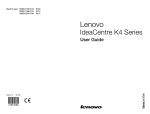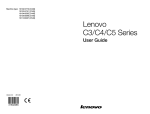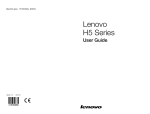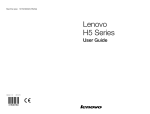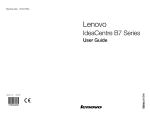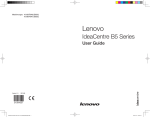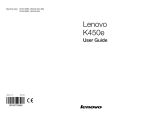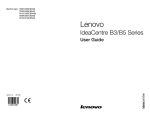Download Lenovo IdeaCentre H520s
Transcript
Machine type: 10093/2561/4746 H5s Series User Guide Version 1.0 2012.02 31501722 Important Safety Information Before using this manual, it is important that you read and understand all of the related safety information for this product. Refer to the Safety and Warranty Guide that you received with this product for the latest safety information. Reading and understanding this safety information reduces the risk of personal injury or damage to your product. Danger: Be aware of extremely hazardous or lethal situations. Attention: Be aware of possible damage to programs, devices, or data. Note: Pay attention to this important information. © Copyright Lenovo 2012. All rights reserved. LIMITED AND RESTRICTED RIGHTS NOTICE: If data or software is delivered pursuant a General Services Administration “GSA” contract, use, reproduction, or disclosure is subject to restrictions set forth in Contract No. GS-35F-05925. © 2012. Lenovo Contents Important Safety Information Chapter 1 Using the Computer Hardware............................... 1 1.1Front view of the chassis..........................................................2 1.2Rear view of the chassis...........................................................3 1.3Connecting your computer.......................................................4 1.4Audio configuration instruction..................................................6 1.5Connect the power cords properly to grounded electrical outlets......................................................................................7 1.6How to play Blu-ray Discs (selected models only).....................7 1.7Wired keyboard (selected models only).....................................8 Chapter 2 Using the Rescue System....................................... 9 2.1OneKey Recovery...................................................................10 2.2Driver and Application Installation...........................................10 2.3System Setup.........................................................................11 2.4System Backup......................................................................12 2.5System Recovery...................................................................12 2.6Create Recovery Disc.............................................................12 Chapter 3 Troubleshooting and Confirming Setup............... 13 3.1Troubleshooting Display Problems..........................................14 3.2Troubleshooting Audio Problems............................................15 3.3Troubleshooting Software Problems.......................................15 3.4Troubleshooting Problems with Optical Drives and Hard Disks..............................................................................16 3.5Special considerations for troubleshooting Windows..............17 3.6Performing Daily Maintenance Tasks.......................................18 Contents 1 Chapter 4 Hardware Replacement Guide.............................. 19 4.1Locations...............................................................................22 4.2Replacing hardware................................................................25 Appendix......................................................................................35 Energy Star Statement..................................................................37 2 Contents Chapter Using the Computer Hardware This chapter contains the following topics: Computer hardware introduction Information on computer connections Note: The descriptions in this chapter might be different from what you see on your computer, depending on the computer models and configurations. User Guide 1 1.1 Front view of the chassis Attention: Be careful not to block any air vents on the computer. Blocked air vents can cause overheating. Power button Memory card reader (selected models only) USB connectors Optical drive eject button Headphone connector Optical Drive (selected models only) Hard disk drive indicator Microphone connector Note: This computer only can be placed in a vertical position. Attention: Do not insert 3-inch discs into the optical drive. 2 User Guide 1.2 Rear view of the chassis (If the rear view configuration shown in this chapter is different from the rear of your computer, please refer to the rear of your computer.) USB connectors WiFi antenna (selected models only) HDMI connector (selected models only) On-board VGA connector Ethernet connector Audio connectors PCI Express X 16 graphics adapter connector (some models are equipped with a graphics card) PCI Express X 1 adapter connector (some models are equipped with USB 3.0 or TV tuner card) Power connector Voltage selection switch (selected models only) User Guide 3 Note: If your model has two VGA monitor connectors, be sure to use the connector on the graphics adapter. Attention: Do not open the WiFi antenna cover. 1.3 Connecting your computer Use the following information when connecting your computer. • Look for the small connector icons on the back of your computer. Match the connectors to the icons. • If your computer cables and connector panel have color-coded connectors, match the color of the cable end with the color of the connector. Note: Your computer may not have all of the connectors described in this section. 1.3.1Check the position of the voltage-selection switch on the rear of the computer. Use a ballpoint pen to slide the switch if necessary. Note: Some computers do not have a voltage switch. These computers control voltage automatically. • If the voltage supply range is 100-127 V AC, set the switch to 115 V. • If the voltage supply range is 200-240 V AC, set the switch to 230 V. 115 230 1.3.2Basic connector instructions Connector Description Microphone Use this connector to attach a microphone to your computer when you want to record sound or if you use speech-recognition software. 4 User Guide Headphone Use this connector to attach headphones to your computer when you want to listen to music or other sounds without disturbing anyone. Audio line-in connector Used to receive audio signals from an external audio device, such as a stereo system. When you attach an external audio device, a cable is connected between the audio line-out connector of the device and the audio line-in connector of the computer. Audio line-out connector Used to send audio signals from the computer to external devices, such as powered stereo speakers (speakers with built-in amplifiers), headphones, multimedia keyboards, or the audio line-in connector on a stereo system or other external recording device. USB connector Use this connector to attach a device that requires a USB connection. Ethernet connector Use this connector to attach the computer to an Ethernet-type local area network. VGA connector Used to attach a VGA monitor or other devices that use a VGA monitor connector. DVI connector Used to attach a DVI monitor or other devices that use a DVI monitor connector. HDMI connector (optional) Connects to the HDMI connector on your display or TV. TV-Tuner connector (optional) Only supported on systems with optional TV tuner card. Note: If your computer is equipped with a wireless keyboard or mouse, follow the installation instructions for those devices. User Guide 5 1.4 Audio configuration instruction (This instruction is only for PC models whose mainboard supports audio transforming from 2.0 stereo to 5.1 surround.) This model of computer supports transforming stereo sound into 5.1 surround sound. Use the following guides when connecting to the 5.1 surround audio device: Blue line-in connector Surround Green line-out connector Front channel Pink Mic-in connector Center-LEF The configurations are as follows: 1. Right click the sound icon in system property bar and select the sounds option to setup the sounds in the pop-up dialog box. 2. Select a playback device from the playback dialog box, and then click the configure button to configure it. 3. Select 5.1 surround from audio channels in the pop-up speaker setup dialog box to proceed with the speaker setup by following as prompted. 4. After the configuration, 5.1 surround can be used. Note: If the audio configuration interfaces in above differ from your actual computer, you may use the above steps as reference to configure the 5.1 surround audio device in your actual audio configuration interface and read the electronic help information for further assistance. 6 User Guide 1.5 Connect the power cords properly to grounded electrical outlets 1.6 How to play Blu-ray Discs (selected models only) Check the connectors available on your computer and display and select an appropriate cable according to this table. Because other types of cables do not meet the requirements of the Blu-ray standard. You need to purchase the cable separately if the computer is not equipped with the corresponding cable. This table will help you to identify the connectors on your computer and display. Connection Type DVI to DVI (DVI cable) DVI to HDMI (DVI-HDMI cable) HDMI to HDMI (HDMI cable) HDMI to DVI (HDMI-DVI cable) Computer Cable Display User Guide 7 1.7 Wired keyboard (selected models only) LVT ——After entering Windows, press this key to launch the LVT (Lenovo Vantage Technology) program, Lenovo’s pre-loaded Home PC software. In addition to its own functions, the LVT program will allow you to start other Windows compatible software, specially configured to run on this model of computer. F2 ——Your computer has the Lenovo Rescue System installed. To learn more about this program, repeatedly press and release the F2 key once turning on the computer until the Lenovo Rescue System open. 8 User Guide Chapter Using the Rescue System This chapter contains the following topics: OneKey Recovery Driver and Application Installation System Setup System Backup System Recovery Create Recovery Disc Attention: Using this program will result in loss of data. • You can restore the C: drive of the computer to factory default settings or to the last system backup status using OneKey Recovery. If you do this, all of the existing data on drive C: will be lost, but the content and format of the other partitions of the hard disk drive will remain unchanged. • If you want to install an operating system and back it up with OneKey Recovery, you must format the C: partition in NTFS format and install the operating system on the C: partition. Otherwise, the OneKey Recovery system cannot run. User Guide 9 Note about the service partition: The files and relevant data used by the rescue system are saved in the service partition. Deleting this partition will make the rescue system unusable. For more detailed information, see the following instructions: By selecting Control Panel → Administrative Tools → Computer Management → Disk Management, you can see the service partition, which must not be deleted. Note: The recovery files and relevant data used by the rescue system are saved in the service partition. If the service partition is deleted or damaged by someone other than authorized Lenovo service personnel, Lenovo will not be liable for any losses arising therefrom in any way. 2.1 OneKey Recovery OneKey Recovery is an easy-to-use application. You can use it to restore your computer to the system default or to a previously backed up state. Detailed Operation Procedure 1. Repeatedly press and release the F2 key once turning on the computer until the Lenovo Rescue System open, then select OneKey Recovery. Note: System Recovery will overwrite all of the data on the C: drive. To prevent loss of data, be sure to back up relevant data before performing system recovery. 2. Follow the on-screen instructions to select the backup task you want to restore from and the disk where you want to install the operating system, then press Next to start the restore. 3. Please wait during the process of system recovery. Do not interrupt the operation during the recovery process. 4. After the system is recovered successfully, the software will prompt you to restart the computer. Restart the computer and start the operating system. 2.2 Driver and Application Installation The Driver and Application Installation function in the rescue system provides a way for the user to conveniently reinstall all of the Lenovo applications and drivers that were shipped with your Lenovo hardware. 10 User Guide Method 1: Automatic Installation Repeatedly press and release the F2 key once turning on the computer until the Lenovo Rescue System open, then select Drivers and Application Installation. Follow the on-screen prompts to install the Lenovo drivers and applications. Click Install to start installing the Lenovo Drivers and Application Installation software. The system will restart. After the system has restarted, the installation process will continue until it has completed. Method 2: Manual Installation In the Windows system, Click Start → All Programs → Lenovo → Lenovo Drivers and Application Installation. After starting the procedure, install all the drivers and software manually by following the prompts. Notes: 1. Do not install software which is already installed on the computer. 2. Make sure that the Drivers and Application Installation software has been automatically installed before starting the operating system. The manual installation function can only be used after the software has been installed. 2.3 System Setup System Setup configures the network configuration for the Lenovo Rescue System to ensure your Rescue System can connect to internet. In addition, System Setup sets and manages all passwords for the Lenovo Rescue system. 2.3.1Launch Repeatedly press and release the F2 key once turning on the computer until the Lenovo Rescue System open, then select System Setup. 2.3.2Network Settings Depending on the network access mode of the computer, select “ADSL” or “LAN Connection” in the network connection modes. 1. If you select “ADSL” input the username and password of the ADSL connection. User Guide 11 2. If you select “LAN connection” configure the IP address and proxy server of the LAN. 2.3.3Password Management Password Management allows you to set and manage the password for Lenovo Rescue System. The default password is blank. Set a password when you access Password Management for the first time. If you don’t want to set a password, access the system directly and operate it accordingly. 2.4 System Backup This backs up your system partition to an image file. In case of a system failure, you can restore your system from this image file. In the Windows system, click Start → All Programs → Lenovo → Lenovo Rescue System. After starting Rescue System, click System Backup to back up your system partition by following the prompts. 2.5 System Recovery Reboot your computer into the system recovery environment. You can choose to restore to a system backup point or the initial state (factory default settings). 2.6 Create Recovery Disc Create a bootable recovery disc from the current system. These recovery discs are used to boot your computer and will guide you through the entire restoration process. In the Windows system, click Start → All Programs → Lenovo → Lenovo Rescue System. After starting Rescue System, click Create Recovery Disc to create a bootable recovery disc from the current system. Follow the on-screen prompts to create recovery discs. 12 User Guide Chapter Troubleshooting and Confirming Setup This chapter contains the following topics: Troubleshooting and Problem Resolution Note: The description of the TV tuner card in this manual is only used for the machines which have the TV tuner card. It does not apply to those machines that do not have a TV tuner card. User Guide 13 Solving Problems Follow these tips when troubleshooting your computer: • If you added or removed a part before the problem started, review the installation procedures to ensure that the part is correctly installed. • If a peripheral device does not work, ensure that the device is properly connected. • If an error message appears on the screen, write down the exact message. This message may help support personnel diagnose and fix the problem(s). • If an error message occurs in a program, see the program’s documentation. Note: The procedures in this document were written for the Windows default view, so they may not apply if you set your Lenovo® computer to the Windows Classic view. 3.1 Troubleshooting Display Problems Problem: Blank screen or no image is displayed on the monitor. Troubleshooting and problem resolution: 1. Check to see if the monitor has been turned on; if not, press the Power button. 2. Check to see if the monitor power cord is loose; if so, plug the power cord securely into the monitor. 3. Check to see if the signal cable to the monitor is securely connected to the connector on the computer graphics card; if not, shut down the computer then connect the signal cable of the monitor securely to the connector on the computer graphics card. Problem: You need to change the display property settings. Setting display background and icon properties: 1. Right-click the desktop anywhere except over an icon, then select Personalize from the pop-up menu. 2. From here, select the appropriate options to: • Change the desktop background • Select a screen saver • Select colors and appearance options for icons and text • Set resolution and colors in the Display Settings options 14 User Guide Problem: Ripple on screen. Troubleshooting and problem resolution: 1. Check to see if any of the following devices are located less than one meter from the computer: refrigerators, electric fans, electric dryers, UPS systems, regulators, fluorescent lamps or other computers that may be generating magnetic interference. 2. Move any interfering devices away from the computer. 3. If the problem persists, contact Lenovo Service. 3.2 Troubleshooting Audio Problems Problem: No sound from the integrated speakers. Troubleshooting and problem resolution: • Adjust the Windows volume control — double-click the speaker icon in the lower-right corner of your screen. Ensure that the volume is turned up and the sound is not muted. Adjust the volume, bass, or treble controls to eliminate distortion. • Reinstall the audio driver. • Disconnect any headphones from the headphone connector — sound from the speakers is automatically disabled when headphones are connected to the computer’s side-panel headphone connector. Problem: No sound from headphones. Troubleshooting and problem resolution: • Check the headphone cable connection — ensure that the headphone cable is securely inserted into the headphone connector. • Adjust the Windows volume control — click or double-click the speaker icon in the lower-right corner of your screen. Ensure that the volume is turned up and the sound is not muted. 3.3 Troubleshooting Software Problems Problem: You are unable exit a running program normally. Troubleshooting and problem resolution: 1. Open the Task Manager window by pressing Ctrl, Alt and Delete at the same time. 2. Select the Application tab, select the problem program, then click the End Task button. User Guide 15 Problem: You need to install or uninstall a program. Problem resolution: During installation never abort the install process by powering the system off or through other drastic means. This can cause system program disorder or even failure during system initialization. During the uninstall process, never directly delete the files or folders. This is harmful to the system, and might cause a system-wide malfunction. Use the following procedure to properly uninstall programs: 1. Back up all documents and system settings related to the program before removing it. 2. If the program has its own uninstaller, run it directly to uninstall the program. 3. If the program does not have its own uninstaller, then select Control Panel from the Start menu. 4. From the Control Panel, choose Programs and Functions. 5. Find the applicable program from the Programs and Functions dialog box and then select Uninstall/Modify. 6. Perform the instructions displayed to uninstall the software. 3.4 Troubleshooting Problems with Optical Drives and Hard Disks Problem: The Optical drive is unable to read a CD/DVD. Troubleshooting and problem resolution: 1. Check to determine if there is an optical drive icon in the resource manager of the operating system. If not, restart your computer. If there is still no icon, contact Lenovo Service. Otherwise, continue with the next step of this procedure. 2. Confirm that the CD/DVD has been properly placed in the drive. If not, reload the CD or DVD. Otherwise, continue with the next step of this procedure. 3. Check the specifications that came with your computer to confirm that this optical drive is capable of reading this type of CD or DVD. 4. If the CD/DVD cannot be read, replace it with a known good CD/DVD such as one that was shipped with the computer. 5. If the known good CD cannot be read, visually check the operating side of the CD/DVD for defects. 16 User Guide Problem: The capacity of the hard disk, as indicated by the system, is less than the nominal capacity. Troubleshooting and problem resolution: For computers equipped with the OneKey Recovery feature, the system recovery feature needs to occupy some hard disk space. This may account for the apparent hard disk capacity deficit. Further Technical Explanation: The nominal capacity of the hard disk is expressed in the decimal system, 1000 bytes. But the actual hard disk capacity is expressed in the binary system as 1024 bytes (For example, the nominal capacity 1G is 1000M, while the actual capacity 1G is 1024M). The capacity of the hard disk shown in Windows can be calculated according to the calculations in the following example: The nominal capacity of the hard disk is 40G, while its actual capacity should be: 40 x 1000 x 1000 x 1000/(1024 x 1024 x 1024) = 37G. If the Service partition of 3G - 3 x 1000 x 1000 x 1000/(1024 x 1024 x 1024) = 2.79G is subtracted, the capacity of the hard disk shown in the system can be obtained. The capacity of the hard disk as calculated using this method may be slightly different from the actual capacity due to the rounding of totals. 3.5 Special considerations for troubleshooting Windows Record the following information as it may be useful later when troubleshooting system problems: 1. The serial number of the software. The serial number was shipped with the computer and provided separately by the manufacturer. The Help Center is unable to retrieve this number. 2. The drivers for this computer model only support the Windows 7 system. 3. When you use the Windows Media Center to watch TV, be particularly attentive to the following: • In the following two situations, you must re-save a channel list: a. When you change your TV signal from digital to analog, your saved channel list for digital TV is deleted. When you want to watch digital TV again, you must create and save a new channel list. b. When you change your TV signal from analog to digital, your saved channel list for analog TV is deleted. When you want to watch analog TV again, you must create and save a new channel list. User Guide 17 • You must set the TV tuner input signal to analog before you can watch Teletext programming. 3.6 Performing Daily Maintenance Tasks Cleaning the computer components Because many of the computer components consist of sophisticated integrated circuit boards, it is very important to periodically clean the computer to prevent dust buildup. The cleaning supplies you need to clean the components include: a vacuum cleaner, a soft cotton cloth, clear water (preferably purified or distilled water) and cotton swabs. Attention: Before you clean your computer, disconnect the computer from the electrical outlet. Clean your computer with a soft cloth dampened with water. Do not use liquid or aerosol cleaners, which may contain flammable substances. Note: To avoid damaging the computer or display, do not spray cleaning solution directly onto the display. Only use products specifically designed for cleaning displays, and follow the instructions included with the product. The following are general methods for cleaning the components: • You can use a soft cloth to remove dust on the surface of the computer, the monitor, the printer, the speakers and the mouse. • You can use a vacuum cleaner to clean in otherwise inaccessible corners. • To clean the keyboard thoroughly, shut down the computer and scrub it gently with a wet cloth. Do not use the keyboard until it is dry. Do not do any of the following: • Allow water to enter the computer. • Use a heavily dampened cloth. • Spray water directly onto the surface of the monitor or inside the computer. LCD monitors should be cleaned daily. Use a dry cloth to brush dust from the monitor and keyboard every day. Keep all surfaces clean and free of grease stains. 18 User Guide Chapter Hardware Replacement Guide This chapter contains the following topics: Identifying internal components Identifying parts on the system board Removing the computer cover Removing the front bezel Replacing a memory module Replacing a hard disk drive Replacing an optical drive Replacing the keyboard and mouse User Guide 19 Overview This guide is intended to be used by customers who are replacing Customer Replaceable Units (CRUs) as well as trained service personnel who are replacing Field Replaceable Units (FRUs). In this guide, CRUs and FRUs will often be referred to as parts. Note: Trained service personnel should refer to the Hardware Maintenance Manual (HMM) for parts ordering information. This guide does not include procedures for all parts. It is expected that cables, switches, and certain mechanical parts can be replaced by trained service personnel without the need for step-by-step procedures. Note: Use only parts provided by Lenovo®. The description of the TV-Tuner card in this manual applies only to computer models that have a TV-Tuner card installed. It does not apply to computer models that do not have a TV-Tuner card installed. This guide contains procedures for replacing the following parts: • Memory modules • Hard disk drive • Optical drive • Keyboard, Mouse (wired) Safety information for replacing CRUs Do not open your computer or attempt any repair before reading the “Important safety information” in the Safety and Warranty Guide that was included with your computer. If you no longer have this copy of the Safety and Warranty Guide, you can obtain one online from the Support Web site at http://consumersupport.lenovo.com. 20 User Guide Additional information resources If you have Internet access, the most up-to-date information for your computer is available from the World Wide Web. You can find the following information: • CRU removal and installation information • Publications • Troubleshooting information • Parts information • Links to other useful sources of information To access this information, go to http://consumersupport.lenovo.com. Tools required To disassemble the computer, you need the following tools: • Wrist grounding strap and conductive mat for preventing electrostatic discharge • Flat screwdriver • Phillips screwdriver • Hex screwdriver • Plastic flat screwdriver • Plastic tweezers Note: The screws for different components vary in size. During the disassembly procedure, group the screws with their corresponding components to avoid a mismatch when replacing the components. User Guide 21 Handling static-sensitive devices Static electricity, although harmless to you, can seriously damage computer components. When you are replacing a part, do not open the anti-static package containing the new part until the defective part has been removed from the computer and you are ready to install the new part. When you handle parts and other computer components, take these precautions to avoid static electricity damage: • Limit your movement. Movement can cause static electricity to build up around you. • Always handle parts and other computer components carefully. Handle adapters, memory modules, system boards, and microprocessors by the edges. Never touch any exposed circuitry. • Prevent others from touching the parts and other computer components. • Before you replace a new part, touch the anti-static package containing the part to a metal expansion slot cover or other unpainted metal surface on the computer for at least two seconds. This reduces static electricity in the package and your body. • When possible, remove the new part from the anti-static packaging and install it directly in the computer without setting the part down. When this is not possible, place the anti-static package that the part came in on a smooth, level surface and place the part on it. • Do not place the part on the computer cover or other metal surface. 4.1 Locations This section provides illustrations to help locate the various connectors, controls and components of the computer. To remove the computer cover, refer to “Removing the computer cover”. 4.1.1Locating components and connectors The following illustrations will help you to locate the various components and connectors in your computer. 22 User Guide Internal components The following illustration shows the components inside your computer. 3 2 1 4 5 Heatsink and system fan System board Optical disk drive and bay Hard disk drive Power supply User Guide 23 4.1.2Identifying parts on the system board The system board (sometimes called the planar or motherboard) is the main circuit board in your computer. It provides basic computer functions and supports a variety of devices that are factory-installed or that you can install later. 1 2 3 4 5 6 7 8 9 20 19 18 17 16 24 15 14 13 12 11 10 12V power connector Microprocessor and heat sink Microprocessor fan header Memory slots (2) Thermal sensor header Power connector Battery SATA connectors (3) eSATA connector Power fan header Front panel connector Clear CMOS jumper Front USB connectors (2) Mini PCI-E slot Mode switch connector Serial (COM2) connector User Guide PCI express X 1 adapter slots (3) Front audio connector PCI express X 16 adapter slot System fan header 4.2 Replacing hardware Attention: Do not remove the computer cover or attempt any repair before reading the “Important safety information” in the Safety and Warranty Guide that was included with your computer or in the Hardware Maintenance Manual (HMM) for the computer. To obtain copies of the Safety and Warranty Guide or HMM, go to the Support Web site at http://consumersupport.lenovo.com. Note: Use only parts provided by Lenovo. 4.2.1General information Pre-disassembly instructions Before proceeding with the disassembly procedure, make sure that you do the following: 1. Turn off the power to the system and all peripherals. 2. Unplug all power and signal cables from the computer. 3. Place the system on a flat, stable surface. 4.2.2Removing the computer cover Attention: Turn off the computer and wait 3 to 5 minutes to let it cool down before removing the cover. To remove the computer cover: 1. Remove any media (disks, CDs, or memory cards) from the drives, shut down your operating system, and turn off the computer and all attached devices. 2. Unplug all power cords from electrical outlets. 3. Disconnect all cables attached to the computer. This includes power cords, input/output (I/O) cables, and any other cables that are connected to the computer. Refer to “Locating connectors on the rear of the computer”. 4. Remove the 2 screws that secure the computer cover at the rear of the chassis. User Guide 25 5. Slide the computer cover toward the rear of the chassis to remove. Note: For this procedure, it helps to lay the computer on a flat, stable surface. 26 User Guide 4.2.3Removing the front bezel To remove the front bezel: 1. Remove the computer cover. Refer to “Removing the computer cover”. Note: For this procedure, it helps to lay the computer on a flat, stable surface. 2. Remove the front bezel by releasing the three plastic tabs inside the chassis and pushing the bezel outward as shown. 3. To reattach the bezel, align the plastic tabs on the bottom of the bezel with the corresponding holes in the chassis, and then snap it into position at the bottom and top of the chassis. 4. Refer to “Completing the installation”. User Guide 27 4.2.4Replacing an optical drive Attention: Do not remove the computer cover or attempt any repair before reading the “Important safety information” in the Safety and Warranty Guide that was included with your computer or in the Hardware Maintenance Manual (HMM) for the computer. To obtain copies of the Safety and Warranty Guide or HMM, go to the Support Web site at http://consumersupport.lenovo.com. To replace an optical drive 1. Remove the computer cover. Refer to “Removing the computer cover”. 2. Remove the front bezel. Refer to “Removing the front bezel”. 3. Remove the 2 screws that secure the optical disk drive bay to the chassis. 4. Slide out the optical disk drive bay, then lift it up. 2 1 28 User Guide 5. Disconnect the data and power cables from the rear of the optical drive. 6. Remove the 2 screws that secure the optical drive to the optical drive bay and push the optical drive straight out of the front of the drive bay. 5 3 4 7. Slide the new optical drive into the bay from the front, then attach it to the drive bay with the screws. 8. Connect the data and power cables to the new optical drive. 9. Slide the optical disk drive bay back, then push it in and and reattach it to the chassis with the screws. 10.Reattach the front bezel. Refer to “Removing the front bezel”. 11.Refer to “Completing the installation”. User Guide 29 4.2.5Replacing the hard disk drive Attention: Do not remove the computer cover or attempt any repair before reading the “Important safety information” in the Safety and Warranty Guide that was included with your computer or in the Hardware Maintenance Manual (HMM) for the computer. To obtain copies of the Safety and Warranty Guide or HMM, go to the Support Web site at http://consumersupport.lenovo.com. To replace the hard disk drive 1. Remove the computer cover. Refer to “Removing the computer cover”. 2. Remove the front bezel. Refer to “Removing the front bezel”. 3. Remove the optical disk drive bay. Refer to “Replacing an optical drive”. 4. Remove the screw that secures the hard disk drive bay to the chassis. 5. Slide out the hard disk drive bay, then lift it up. Disconnect the data and power cables from the hard disk drive. 4 2 3 1 30 User Guide 6. Remove the 4 screws that secure the hard disk drive to the bay. 7. Slide the hard disk drive out of the bay. 8. Install the new hard disk drive. (1) Insert the new hard disk drive into the drive bay. (2) Screw back the 4 screws on the drive bay. 9. Attach the data and power cables to the new hard disk drive. 10.Line up the hard disk drive bay, then slide it in. Reattach it to the chassis with the screws. 11.Reattach the optical drive disk bay. Refer to “Replacing an optical drive” 12.Reattach the front bezel. Refer to “Removing the front bezel”. 13.Refer to “Completing the installation”. 4.2.6Replacing a memory module Attention: Do not remove the computer cover or attempt any repair before reading the “Important safety information” in the Safety and Warranty Guide that was included with your computer or in the Hardware Maintenance Manual (HMM) for the computer. To obtain copies of the Safety and Warranty Guide or HMM, go to the Support Web site at http://consumersupport.lenovo.com. User Guide 31 To replace a memory module: 1. Remove the computer cover. Refer to “Removing the computer cover”. Note: For this procedure, it helps to lay the computer on a flat, stable surface. 2. Locate the memory module connectors. Refer to “Locating components”. 3. Remove the memory module being replaced by opening the retaining clips as shown. 4. Position the new memory module over the memory connector. Make sure on the memory module is correctly aligned with the connector the notch on the system board. Push the memory module straight down into the key connector until the retaining clips close. 5. Refer to “Completing the installation”. 32 User Guide 4.2.7Replacing the keyboard and the mouse To replace the keyboard: 1. Remove any media (disks, CDs, or memory cards) from the drives, shut down your operating system, and turn off the computer and all attached devices. 2. Unplug all power cords from electrical outlets. 3. Locate the connector for the keyboard. Refer to “Locating connectors on the rear of the computer” and “Locating connectors on the front of the computer”. Note: Your keyboard will be connected to the USB connector at either the front or the rear of the computer. 4. Disconnect the failing keyboard cable from the computer and connect the new keyboard cable to the same connector. 5. The mouse can be replaced using the same method. 4.2.8Completing the installation After replacing the parts, you need to close the computer cover and reconnect cables, including telephone lines and power cords. Also, depending on the part that was replaced, you might need to confirm the updated information in the Setup Utility program. Refer to “Starting the Setup Utility” in the Hardware Maintenance Manual. To complete the part installation: 1. Ensure that all components have been reassembled correctly and that no tools or loose screws are left inside your computer. Refer to “Locating components”, “Front view of the chassis” and “Rear view of the chassis” for the location of the various components. 2. Make sure that the cables are routed correctly before replacing the computer cover. User Guide 33 3. Position the computer cover on the chassis so that the rail guides on the bottom of the computer cover engage the rails. Then, push the computer cover closed until it snaps into position. Screw back the 2 screws on the chassis. 4. Reconnect the external cables and power cords to the computer. Refer to “Locating connectors on the front of the computer” and “Locating connectors on the rear of the computer”. Note: In most areas of the world, Lenovo requires the return of the defective CRU. Information about this will come with the CRU or will come a few days after the CRU arrives. 34 User Guide Appendix. Declaration Thank you for using Lenovo products. Carefully read all documents shipped with your computer before you install and use the product for the first time. Lenovo is not responsible for any loss except when caused by installation and operations performed by Lenovo professional service personnel. You are responsible if you fail to operate the product according to instructions and requirements in the manuals included with your computer, or operate the product inappropriately. This manual could include technical inaccuracies or typographical errors. Changes are made periodically to the information herein; these changes will be incorporated in new editions of the publication.To provide better service, Lenovo reserves the right to improve and/or modify the products and software programs described in the manuals included with your computer, and the content of the manual, at any time without additional notice. The manuals included with your computer are provided to help you use Lenovo’s products appropriately. For the configuration of the product, refer to the related contract (if any) or product packing list, or consult the distributor for the product sales. The content of the manuals included with your computer is protected by copyright laws and rules. None of the manuals included with your computer may be reproduced or transcribed by any means or translated into any language without prior written permission of Lenovo. The software interface and function and hardware configuration described in the manuals included with your computer might not match exactly the actual configuration of the computer that you purchase.You are welcome to contact us about the manuals included with your computer. For the latest information or any questions or comments, contact or visit the Lenovo Web site: Service Web site: http://consumersupport.lenovo.com User Guide 35 Trademarks Lenovo and the Lenovo logo, IdeaCentre and IdeaCentre logo are trademarks of Lenovo in the United States, other countries, or both. Microsoft, Windows, and Windows Vista are trademarks of the Microsoft group of companies. Intel Inside is a trademark of Intel Corporation in the U.S. and/or other countries. AMD, the AMD Arrow logo, ATI, AMD Athlon, AMD LIVE!, AMD Opteron, AMD Phenom, AMD Sempron, Catalyst, Cool ‘n’ Quiet, CrossFire, PowerPlay, Radeon, and The Ultimate Visual Experience are trademarks of Advanced Micro Devices, Inc. Other company, product, or service names referred to herein or in other Lenovo publications may be trademarks or service marks of others. All rights reserved. Names or marks of certain companies mentioned in the manuals included with your computer or this document do not necessarily indicate that related software or hardware is included. The actual configuration of the product depends on the packing list description. 36 User Guide Energy Star Statement ENERGY STAR® is a joint program of the U.S. Environmental Protection Agency and the U.S. Department of Energy aimed at saving money and protecting the environment through energy efficient products and practices. Lenovo is proud to offer our customers products with an ENERGY STAR compliant designation. The following machine types have been designed and tested to conform to the ENERGY STAR program requirement for computers at the time of manufacture. For more information about ENERGY STAR ratings for Lenovo computers, go to http://www.lenovo.com. • 4746 By using ENERGY STAR compliant products and taking advantage of the powermanagement features of your computer, you reduce the consumption of electricity. Reduced electrical consumption contributes to potential financial sayings, a cleaner environment, and the reduction of greenhouse gas emissions. For more information about ENERGY STAR, go to: http://www.energystar.gov. Lenovo encourages you to make efficient use of energy an integral part of your day-to-day operations. To help in this endeavor, Lenovo has preset the following power-management features to take effect when your computer has been inactive for a specified duration: ENERGY STAR power-management features, by operating system. Microsoft Windows XP Microsoft Windows Vista and Windows 7 • Turn off monitor: After 15 minutes • Turn off hard disk drives: Never • System standby: After 20 minutes • System hibernates: Never Power plan: Balanced • Turn off the display: After 10 minutes • Put the computer to sleep: After 25 minutes • Advanced power settings: - Turn off hard disk drives: After 20 minutes - Hibernate: Never To awaken your computer from a Sleep or System Standby mode, press any key on your keyboard. For more information about these settings, refer to your Windows Help and Support information system. User Guide 37 38 User Guide











































